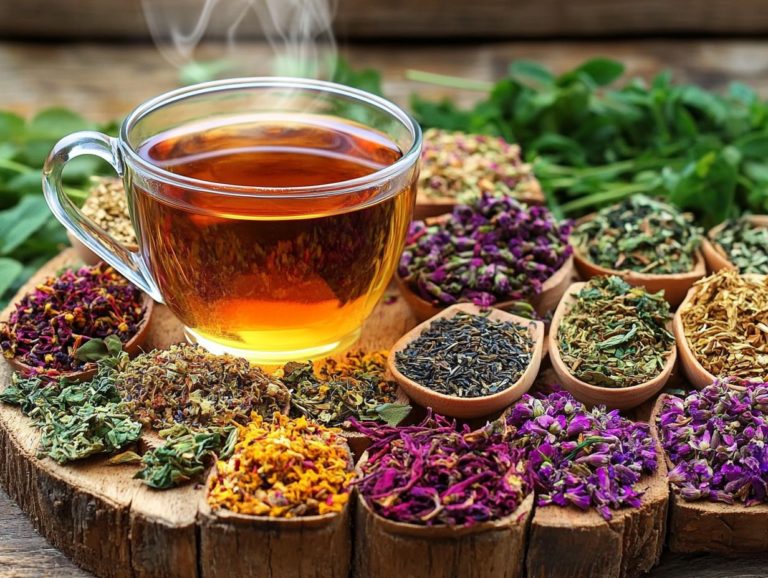What Are the Most Popular Herbs for Pain Relief?
In your quest for natural pain relief, herbal remedies have likely caught your attention. This article covers popular herbs known for pain relief, such as turmeric, ginger, chamomile, peppermint, clove, and white willow bark.
You ll discover how these herbs work to alleviate pain, explore various methods of consumption, and be made aware of essential precautions to consider.
Whether you re looking for alternatives to traditional medications or simply curious about the world of herbal remedies, this guide provides valuable insights for your health journey.
Contents
Key Takeaways:
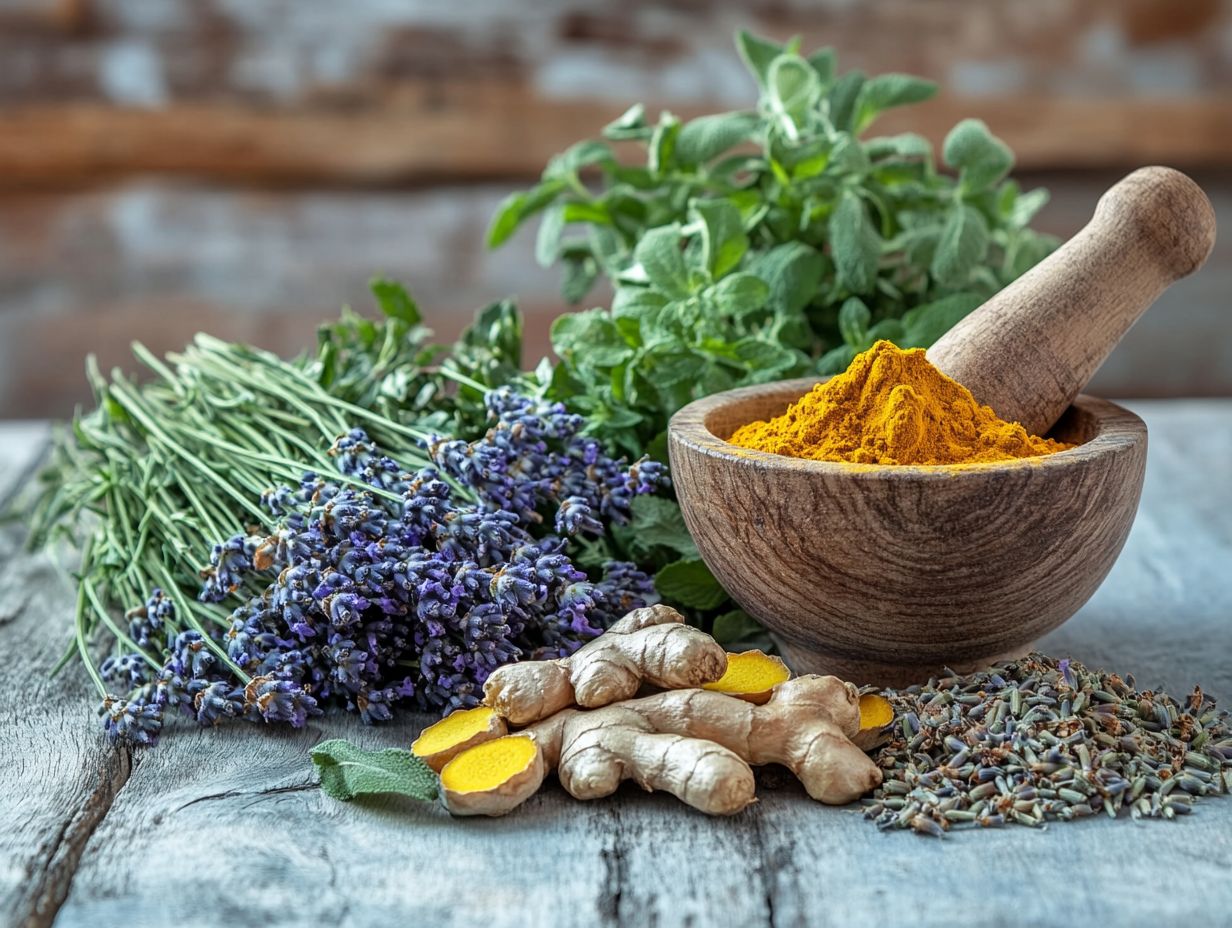
- Turmeric, ginger, chamomile, peppermint, clove, and white willow bark, along with boswellia and devil’s claw, are some of the most popular and effective herbs for pain relief.
- These herbs work by reducing inflammation, blocking pain signals, and promoting relaxation and calmness in the body.
- While herbs can be a safe and natural option for pain relief, it is important to consult with a healthcare professional and use them properly to avoid potential risks and side effects.
What is Herbal Pain Relief?
Herbal pain relief involves using plant-based remedies to ease discomfort from various pain-causing conditions, such as muscle pain, arthritis, and inflammation. This approach focuses on treating the root causes of pain, making it exciting for those seeking natural solutions! Many individuals prefer herbal solutions over conventional pain medications due to their perceived safety and effectiveness.
Notable options like white willow bark, boswellia, and turmeric ginger stand out for their unique anti-inflammatory properties. In this exploration, you will discover the roles of various herbs, including the most common herbal remedies, in effective pain management.
Throughout history, cultures worldwide have relied on plants for healing, with records stretching back thousands of years detailing their use for chronic pain and inflammation relief. Unlike conventional treatments, which often bring significant side effects and addictive tendencies, these natural remedies offer a gentler alternative, seamlessly integrating into holistic health practices that nurture both body and mind.
By addressing root causes like inflammation and stress, herbal pain relief not only alleviates physical discomfort but also enhances overall well-being. With a growing body of scientific research backing their effectiveness, you may find common herbal remedies for headaches increasingly appealing as you seek a more natural approach to pain relief.
Top Herbs for Pain Relief
In terms of herbal remedies for pain relief, a select few herbs truly shine in their ability to alleviate various types of discomfort, from chronic pain to muscle aches and arthritis symptoms.
Take white willow bark, for instance; its salicin content makes it a natural alternative to aspirin, delivering impressive anti-inflammatory effects. Boswellia and devil’s claw also deserve a nod for their effectiveness in managing both inflammation and pain. And let s not overlook turmeric and ginger loaded with curcumin and gingerol, they bring significant health benefits to the table.
For localized relief, cayenne pepper, rich in capsaicin, works wonders when applied topically. Altogether, these herbs form a powerful arsenal for effective pain management.
Turmeric
Turmeric, that vibrant yellow spice you often see in the kitchen, is celebrated for its active compound, curcumin. This remarkable ingredient boasts powerful anti-inflammatory properties, making it a go-to in herbal remedies for pain relief.
This natural powerhouse doesn t just help with arthritis discomfort; it also plays a significant role in managing chronic pain. Many individuals have embraced turmeric, weaving it seamlessly into their daily routines to tap into its potential benefits.
One delightful way to savor this spice is through turmeric ginger tea. This soothing beverage marries the advantages of both turmeric and ginger, offering a comforting drink that may alleviate inflammation and promote overall well-being.
Whether you enjoy it as a tea or sprinkle it into your meals, turmeric stands as a valuable ally in your quest for inflammation relief.
Start your journey to natural pain relief with these herbs today!
Ginger
Ginger is a versatile root with a rich history in traditional herbal treatments. It is celebrated for its powerful anti-inflammatory properties and effectiveness in easing nausea and muscle pain.
You ll love incorporating this remarkable root into your meals. Ginger can be enjoyed in various forms fresh, powdered, or steeped in a soothing infusion of ginger tea. Each form offers unique ways to seamlessly incorporate it into your daily health routine.
Studies show that ginger tea may deliver significant relief for those grappling with chronic pain conditions. Research published in journals dedicated to alternative therapies indicates that the active compounds in ginger, such as gingerol, can aid in reducing inflammation and enhancing joint mobility.
By integrating ginger into your diet, you can elevate the flavors of your meals while tapping into its therapeutic benefits for pain management and overall wellness. Don t miss out on the chance to boost your health with ginger today!
Chamomile
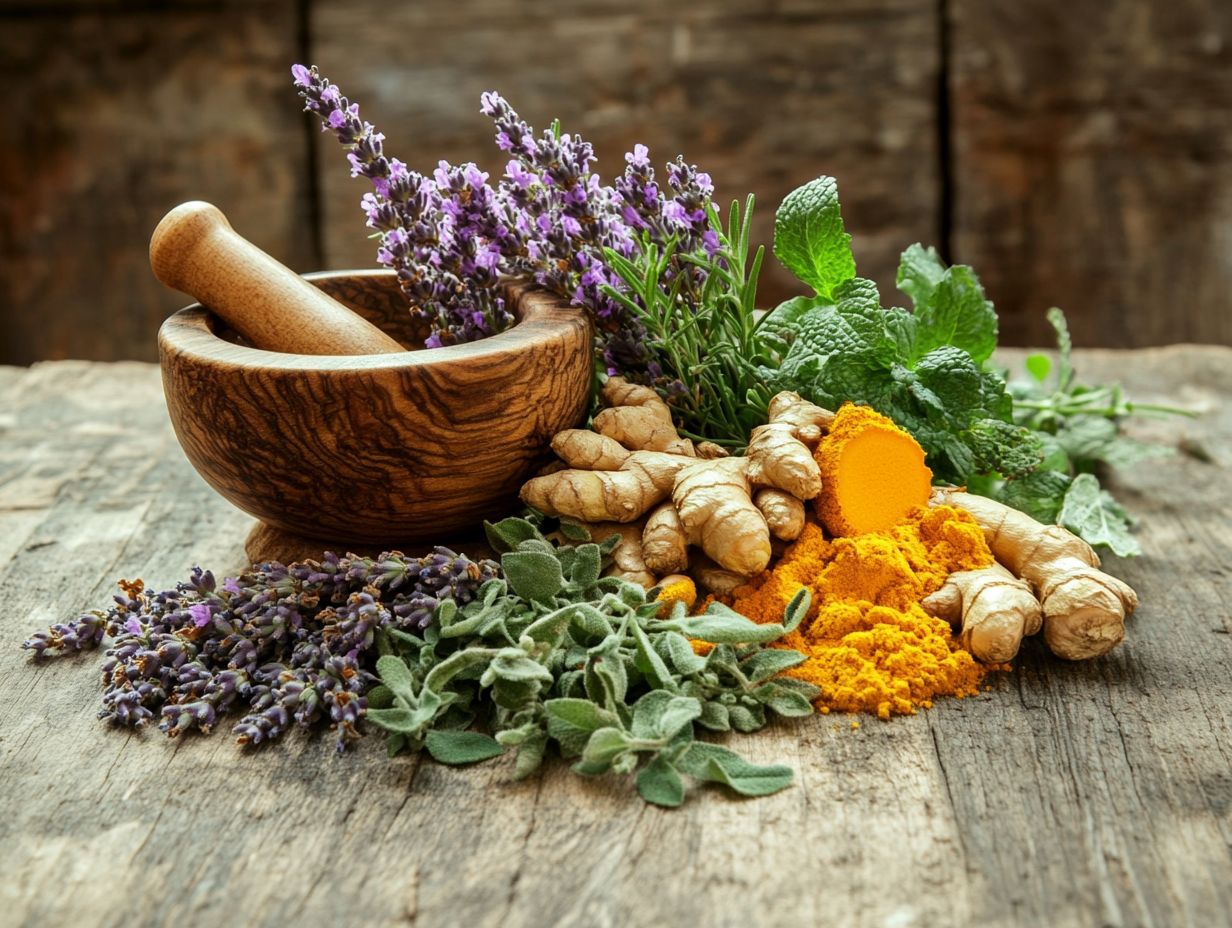
Chamomile, often savored as a soothing herbal tea, stands out for its calming effects and potential to relieve inflammation. This makes it a valuable addition to your holistic health regimen.
This ancient herb has been cherished across cultures for centuries. It is revered for its calming qualities that help alleviate stress and promote relaxation. When you sip chamomile tea, you’re not just enjoying a warm beverage; you’re encouraging better sleep and easing tension after a long day.
Its natural anti-inflammatory properties make it a preferred choice for those seeking relief from discomfort, be it headaches or muscle strains.
Typically prepared by steeping dried flowers in hot water, this straightforward method preserves all the benefits while filling the air with a delightful aroma. By incorporating chamomile into your routine, you may find it contributes to your overall well-being, establishing it as an essential staple in your wellness practices.
Peppermint
Peppermint, renowned for its invigorating aroma, is a staple in essential oils and herbal remedies. It is celebrated for its ability to provide significant pain relief, particularly for headaches and muscle aches.
This versatile herb not only awakens the senses; its menthol component delivers a refreshing coolness that can ease discomfort when applied topically.
If you re grappling with digestive issues, peppermint oil may be your ally. It s known to soothe spasms in the digestive tract and support healthy digestion.
Inhaling its aromatic properties can enhance mental clarity and relaxation. This makes peppermint an invaluable partner in your holistic health journey. Whether you choose to blend it into a soothing massage oil or savor it in a warm cup of tea, this remarkable plant presents a wealth of benefits that are certainly worth exploring.
Clove
Clove, often celebrated as a spice, is rich in eugenol, a compound renowned for its impressive anti-inflammatory properties. This makes clove an effective choice in herbal remedies for pain relief.
You ll find that this powerful compound has a long-standing tradition in medicine, particularly for alleviating dental discomfort and soothing gum inflammation.
Many practitioners advocate for clove oil as a natural alternative to those run-of-the-mill over-the-counter pain relievers. Simply applying a few drops to the affected area can bring you immediate relief, along with 5 herbs for natural pain relief that can enhance your comfort.
Clove-infused mouth rinses have gained popularity for their ability to enhance oral health, acting as a natural antiseptic. Not only does clove elevate your culinary creations, but it also stands as a valuable ally in managing discomfort, highlighting its remarkable versatility in holistic healing practices.
White Willow Bark
White willow bark, often referred to as ‘natural aspirin’, is rich in salicin, a compound known for its effective pain relief. This remarkable herb has been treasured for centuries in herbal remedies.
Its history stretches back to ancient civilizations, where it was esteemed not only for easing headaches but also for its ability to reduce fever and inflammation. Unlike conventional medications, which can come with numerous side effects, this natural alternative offers a gentler, yet powerful way to manage pain!
You may find that white willow bark effectively tackles chronic pain and inflammatory conditions without the gastrointestinal discomfort often linked to over-the-counter pain relievers, making it an excellent choice in herbal remedies.
Its benefits extend well beyond mere pain relief, making it an appealing option for those on a holistic wellness journey.
How These Herbs Work for Pain Relief
To understand how these herbs relieve pain, we must explore their active compounds and how they interact with your body, especially regarding chronic pain and inflammation, which is increasingly relevant in today’s healthcare discussions.
Each herb possesses unique mechanisms that enhance their effectiveness, whether through direct anti-inflammatory properties, pain modulation, or other biological pathways. For instance, curcumin found in turmeric inhibits substances that cause inflammation, while salicin in white willow bark functions similarly to aspirin.
Understanding herbal remedies empowers you to make informed choices for managing your pain-causing conditions.
Using Herbs for Pain Relief
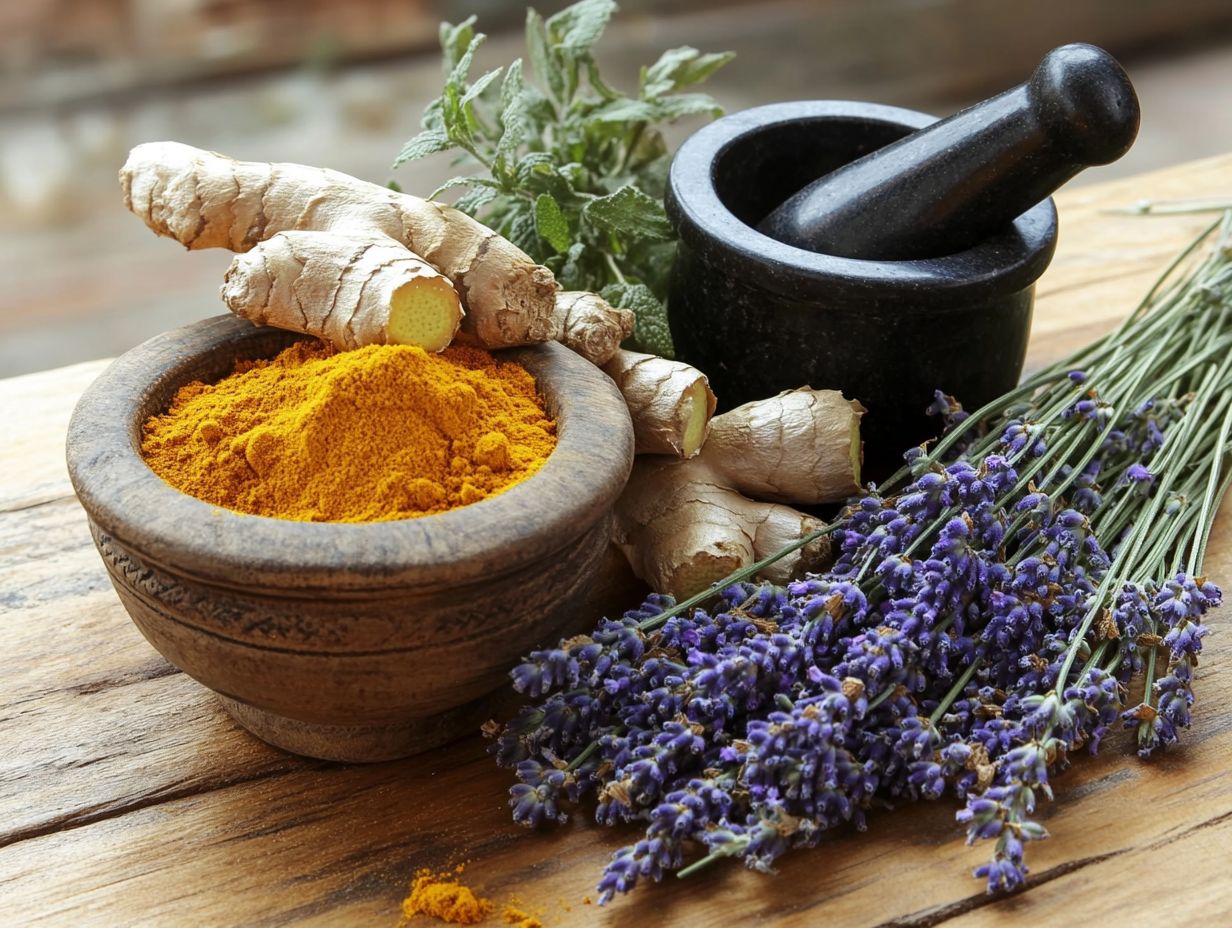
Using herbs for pain relief opens up a world of possibilities, allowing you to integrate them into your healthy diet or utilize essential oils for topical applications. Each method presents unique benefits for effective pain management.
Incorporating ginger or turmeric into your meals enhances your overall health and delivers powerful anti-inflammatory properties, critical for inflammation relief. Applying peppermint oil or eucalyptus oil directly to sore areas can provide targeted relief where you need it most.
Grasping the various methods of consumption is crucial for unlocking the full potential of these herbal treatments in managing muscle pain.
Methods of Consumption
You have various methods to enjoy herbal remedies, from sipping on calming ginger tea to indulging in turmeric-infused drinks or applying essential oils topically for pain relief. These options allow you to tap into the natural benefits that nature offers, enhancing your journey toward holistic health.
Brewing a soothing cup of chamomile tea can work wonders in alleviating stress and promoting relaxation, which is beneficial for overall pain management. For those looking for more options, exploring what herbs are best for stress relief may provide additional support. A few drops of peppermint oil diluted with a carrier oil might be just the ticket to easing headaches and muscle tension, both common issues for those suffering from arthritis symptoms.
Pairing these remedies with a diet rich in antioxidant-laden fruits and vegetables can further enhance your overall wellness, crucial for combating inflammation and promoting natural pain relief.
It’s important to grasp the appropriate dosages for both herbal teas and essential oils, ensuring you maximize their effectiveness while keeping safety in mind, especially when considering botanical extracts. If you’re intrigued by the idea of natural healing, exploring these options now can transform your health!
Potential Risks and Side Effects
Herbal treatments for pain relief can offer effective alternatives. However, it s vital to be aware of the potential risks and side effects that may accompany their use, especially when considering cayenne pepper and other strong herbs.
Alongside these benefits, necessary precautions and warnings must be heeded to ensure your safety. Boswellia may interact with medications or provoke allergic reactions. Thus, consulting a healthcare professional like Rochelle Collins, DO before starting any new regimen is crucial.
Overindulging in white willow bark could lead to gastrointestinal issues. Additionally, specific essential oils might irritate sensitive skin, particularly in individuals with autoimmune diseases.
By being aware of these factors, you can confidently navigate your options and prioritize your well-being. Stay informed about pain management techniques.
Precautions and Warnings
When exploring herbal treatments for pain relief, understand the vital precautions and warnings to avoid potential side effects and interactions with other medications, especially with substances like Bromelain and vitamin E.
Herbs like St. John’s Wort, Turmeric, and Devil’s Claw can significantly influence how your body processes other drugs. While St. John’s Wort may ease mild to moderate pain, it can also lessen the effectiveness of certain antidepressants and birth control pills.
Turmeric, known for its anti-inflammatory benefits, warrants caution for those on blood thinners, as it may enhance the effects of these medications.
Consulting a healthcare provider, like Cathy Wong, is crucial for customizing the amount based on your unique health needs. Recommended dosages can vary widely.
Prioritizing a thorough review of each herb’s specific interactions and safe dosages will help you achieve optimal health outcomes, especially when managing conditions like arthritis or cancer.
Frequently Asked Questions
What Are the Most Popular Herbs for Pain Relief?
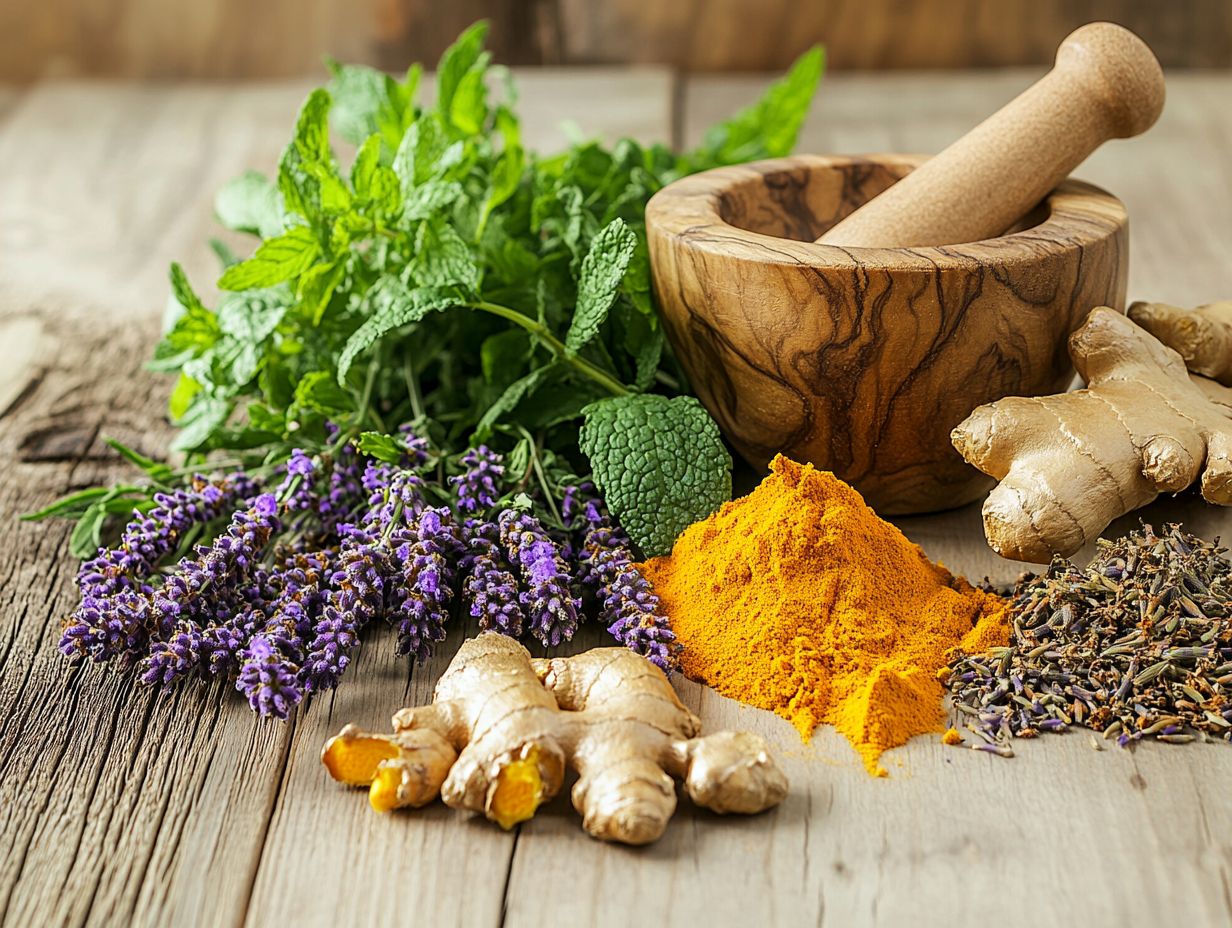
The most popular herbs for pain relief include turmeric, ginger, willow bark, boswellia, devil’s claw, and cayenne pepper.
How does turmeric relieve pain?
Turmeric contains a compound called curcumin, which has anti-inflammatory properties that can help alleviate pain and reduce swelling in the body.
Can ginger be used for pain relief?
Yes, ginger has been shown to have anti-inflammatory effects and can treat pain associated with conditions like osteoarthritis and menstrual cramps, offering a natural approach to pain management.
What is willow bark and how does it help with pain?
Willow bark is a natural source of salicylic acid, the active ingredient in aspirin. It can help reduce pain and inflammation, making it an effective option for managing arthritis symptoms.
Is boswellia effective for pain relief?
Many studies show that boswellia can effectively reduce pain and inflammation, particularly in conditions like osteoarthritis, rheumatoid arthritis, and asthma, providing inflammation relief.
Can devil’s claw be used to relieve joint pain?
Yes, devil’s claw has been traditionally used to treat joint pain. Studies have shown that it may effectively reduce pain and improve mobility in individuals with osteoarthritis and lower back pain, particularly benefiting those with chronic muscle pain.
What is capsaicin and how does it relieve pain?
Capsaicin is the compound found in chili peppers that gives them their spiciness. It works by decreasing the amount of substance P, a chemical that signals pain to the brain, and can be used topically for pain relief, offering a natural alternative for those suffering from chronic conditions.
Take charge of your health! Consult your healthcare provider today.


